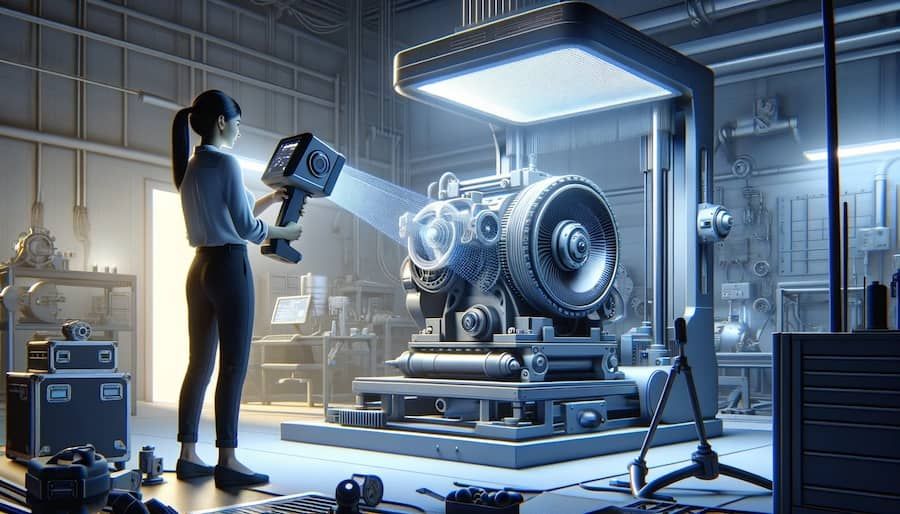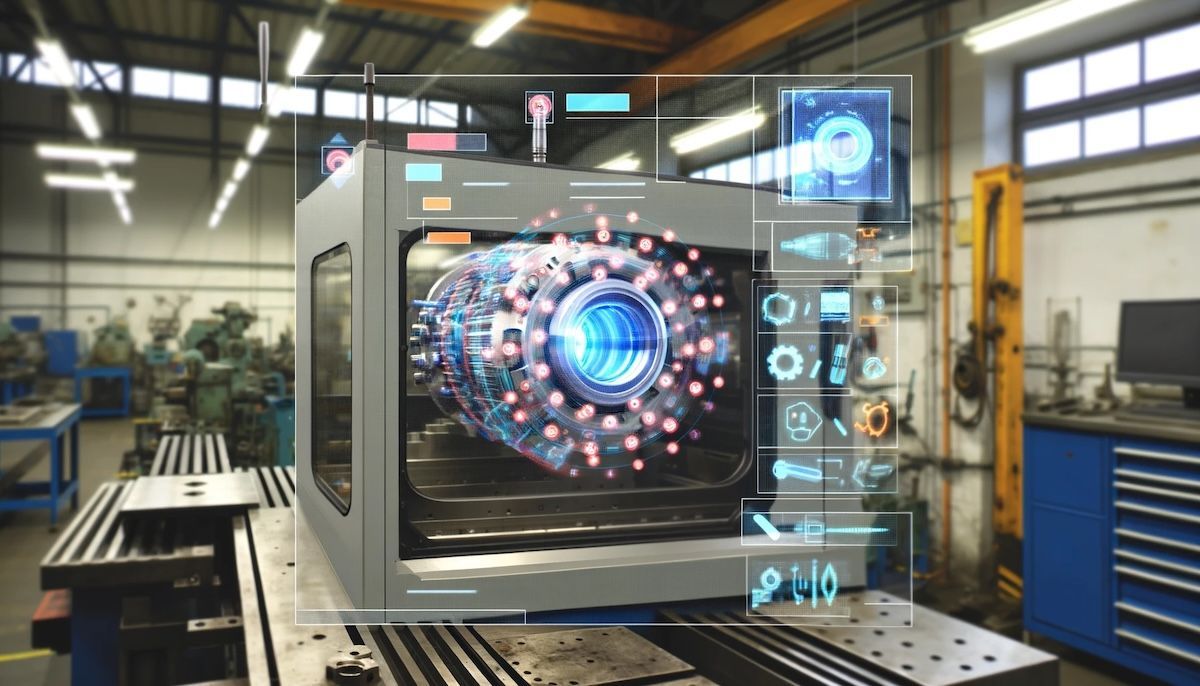
July 29, 2025
Augmented Reality and Artificial Intelligence: The Future of Digital Interaction

Founder/CTO The Spatial Studio, Technology-Enthusiast

In recent years, augmented reality has established itself as an exciting technology for various industries. It is already an integral part of everyday life in industry, e-commerce and marketing.
Contents
Want to know how AI can enhance your AR application?
What is AI in Augmented Reality?
AI in augmented reality refers to the use of artificial intelligence techniques and algorithms to enhance the AR experience. By using AI, AR applications can analyze and understand the user's environment, preferences, and behaviors, resulting in personalized and immersive interactions.
AI in AR brings together two transformative technologies, combining the ability of AI systems to reason and make decisions with the overlaying of digital information on the physical world. This synergy expands the capabilities of AR technology, enabling smarter and more customizable AR experiences.
Industry can leverage this integration to develop innovative solutions and improve their processes.
| AI in AR | Advantage |
|---|---|
| Real-time decision making | AR applications become more responsive and adaptive |
| Personalized experiences | AR adapts to individual preferences and behaviors |
| Enhanced user interactions | Make AR more immersive, engaging, and interactive |
| Innovative Use Cases | AR combined with AI to create new cross-industry solutions |
| Transformative effect | AI-powered AR experiences revolutionize industries and user experiences |
| Content Production | AR content can be produced much faster and cheaper |
AR Content Creation Challenges
Augmented reality (AR) has fundamentally changed the way we interact with the digital world. However, in order to bring it into the mainstream on a large scale, one challenge in particular must be overcome: content creation for AR.
The complexity of 3D modeling
Creating 3D models is at the heart of any AR application. But this is where the difficulties begin. Creating these models is not only a creative process, but also a technical one. It requires not only a good eye for design, but also in-depth technical know-how. Creating detailed and realistic models requires expertise in areas such as texturing, 3D modeling, and mesh optimization. These skills are rare and expensive.
High cost and time
Not to mention the high cost and time involved in creating high-quality AR content. Each model must be carefully designed, developed, and optimized. This process requires not only expertise, but also time - and time, as we all know, is money. For start-ups and smaller companies, this can be an almost insurmountable hurdle. Even for online stores with thousands of products, this can be an insurmountable hurdle.
AI as a content creation solution
Now that we're aware of the challenges of creating content for AR, let's take a look at one promising solution:artificial intelligence (AI).
AI tools as a game changer
In the future, it will be possible to create complex 3D models in a fraction of the time and at a much lower cost. How will this work? This is where AI tools like Midjourney and Dall-ecome in. These innovative tools have the potential to revolutionize the content creation process. They make it possible to generate textures and models with simple instructions or "prompts". This means that even without in-depth knowledge of 3D modeling, impressive results can be achieved.
From idea to model in a few clicks
Imagine you need a texture for a model, such as wood or leather. Instead of spending hours tweaking the perfect texture, a specialist can type a prompt into an AI tool. In no time, a variety of options are generated that can be used for a project. This type of content creation is not only more efficient, but also allows for more creativity and experimentation.
Reduce cost and time
By using AI in content creation, companies can save a significant amount of time and money. Especially for smaller teams or individuals who don't have the resources for a large design team, this can be a game changer. AI does most of the heavy lifting, allowing you to focus on other important aspects of the project.
The future is bright
We are just at the beginning of what AI can do for content creation. Over the next few years, these tools will continue to develop and refine, leading to even more immersive and realistic AR experiences. The combination of AR and AI will not only change the way we create content, but also the way we experience it.
Improving efficiency through AI integration
Now that we've highlighted the revolutionary role of AI in content creation for AR, let's take it a step further and look at the extensive efficiency gains that can be achieved by integrating AI into this process.
Automating and accelerating processes
The true power of AI lies in its ability to automate repetitive and time-consuming tasks. In the world of AR, this means a significant acceleration of content creation. In particular, the hours previously spent texturing and fine-tuning 3D models. AI tools can perform these tasks in a fraction of the time, allowing designers to focus on the more creative and strategic aspects of projects. For example, it will be much easier to create different versions or variants of models. Artificial intelligence is already very strong in these areas.
AI-driven quality improvement
It's not just about speed. Integrating AI into the design process also improves the quality of the results. AI algorithms can detect and optimize patterns that are difficult for the human eye to see. This leads to more accurate and realistic models, which is particularly beneficial in areas such as e-commerce or virtual product visualization (see Virtual Try-on).
Accessibility and democratization of content creation
AI makes AR content creation more accessible. Smaller companies and individuals without large budgets or teams can now create high-quality AR experiences. This democratization of content creation paves the way for a variety of innovations and creative applications that were previously impossible due to resource constraints.
Forward-looking adaptability
As AI technology continues to evolve, we can expect AR development to become more adaptive. This means that AR applications can adapt more quickly to new trends and technological advances, which is essential for businesses that want to stay on the cutting edge.

Virtual-try-on
Advances in Virtual Fittings and AR Filters
Virtual try-on and AR filters are not just exciting social media gimmicks, they are practical tools that are catapulting the shopping experience and digital interaction into the future. Advances in this area, particularly through the integration of AI, are opening doors to new possibilities.
The online shopping revolution
In the future, customers will be able to virtually try on clothes or glasses before they buy them. This is exactly what virtual try-on applications make possible. Thanks to advances in AI technology, these applications are becoming increasingly accurate and realistic. Not only do they help increase customer satisfaction, but they also reduce return rates, which is a huge benefit for online retailers.
Improved tracking with AI
Traditional AR tracking methods, such as edge detection, are technically complex and not always reliable. AI-based tracking, on the other hand, has the potential to overcome these challenges. It can more accurately detect and mark objects such as hands, heads or feet in the image. This leads to a natural and intuitive interaction with AR applications.
Examples from the field
Snap and Apple are leading the way in developing AR filters using AI technologies. Their filters can recognize and track faces and other body parts in real time, producing impressive and entertaining results. This technology is not only interesting for social media, but also for areas such as education, design, and industry.
AI in maintenance and industry
Now we turn to another exciting area of application: the use of artificial intelligence (AI) in maintenance and industry, particularly in the context of augmented reality (AR).
Revolutionizing maintenance processes
In industries such as manufacturing and aerospace, the maintenance and management of complex machines and systems are key challenges. This is where AI combined with AR can make a significant difference. For example, AR glasses or applications on tablets and smartphones can be used to view detailed, interactive 3D models of machines and their components live. AI systems could automatically generate models from technical drawings and manuals and assist maintenance personnel in real time.
AR and AI in manufacturing
In manufacturing, artificial intelligence can take augmented reality to a new level. Information can not only be visualized, but also generated or interpreted. Workers can also interact with the system like an AI assistant. Microsoft has conducted an exciting case study on this topic and presented it in the following video.
AI-based fault diagnosis and repair instructions
By using AI in AR applications, maintenance tasks can be performed faster and more efficiently. For example, AI systems can help diagnose faults faster by analyzing data from multiple sources and drawing conclusions. AR displays can then provide step-by-step instructions on how to repair or replace parts, which is particularly useful in situations where quick and precise action is required.
Training and education potential
The use of AR and AI is also of great value in education and training. Instead of relying on traditional training methods, trainees and technicians can learn hands-on and interactively through AR applications. They can virtually explore complex systems and run through different scenarios, making learning more effective and memorable.
Long-term benefits and sustainability
The use of AR and AI in maintenance and industry not only offers short-term benefits such as time and cost savings, but also contributes to long-term sustainability. More efficient maintenance processes and improved training methods can conserve resources and extend the life of machinery and equipment.
AI in online shopping
The use of artificial intelligence (AI) is not only revolutionizing industrial processes, it is also having a significant impact on online shopping. Here we see how AI combined with augmented reality (AR) is creating entirely new experiences.
AI in online shopping: a new age of e-commerce
Online shoppers can not only view products online, but also experience them in 3D and try them out virtually before they buy. This is exactly what the use of AI ine-commercemakes possible. Creating 3D models is a major hurdle for many shop owners, mainly because of the high costs involved. AI can make this process much easier and cheaper by automatically generating 3D models from existing images and data. This can significantly improve the customer experience while lowering the barriers for smaller stores to integrate AR technologies. We have already outlined the benefits in the virtual try-on area above.
AI's role in the gaming industry
AI is also a game changer in AR gaming. Game development, especially the creation of 3D assets, is a time-consuming and costly process. AI technologies can significantly speed up and improve the design and production process. Companies such as Nvidia are already integrating AI into game development, resulting in more realistic and immersive gaming experiences.
AI-based asset creation tools
In the gaming industry, we are increasingly seeing the use of AI-based tools that can create detailed 3D models from a few images or even text descriptions. This technology is still in its infancy, but has the potential to fundamentally change the way digital content is created.

Scanning Technologies and Their Limitations
In addition to the advanced use of AI in content creation, scanning technologies play an important role in the world of augmented reality (AR). However, these technologies, which often use AI as well, have their own limitations and challenges.
The Role of Scanning Technologies in AR
Modern scanning technologies, such as those from Luma AI or Polycam, make it possible to quickly convert real objects into 3D digital models. This is particularly useful for AR content creation because it simplifies and speeds up the modeling process. With a simple scan, objects can be captured and converted into a digital form that can then be used in AR applications.
Limitations of Current Scanning Technologies
While these technologies are impressive, they have their limitations. The quality of the resulting 3D models is often not as good as hand-crafted models. Textures and details may be inaccurately rendered or simplified, which is not sufficient for high-quality AR applications. As a result, manual post-processing or enhancements are often required to bring the models up to the desired quality level. For premium applications, 3D scanning is still not good enough.
Post-processing challenges
Another issue is post-processing. Although a scan serves as the basis for a 3D model, extensive post-processing is often required, especially when texturing and fine-tuning details. This can be time-consuming and require specialized skills, which can negate some of the initial benefits of fast scanning technology.
The future of coding with AI
The rapid development of artificial intelligence (AI) has not only made significant advances in content creation and interactive applications, but is also increasingly revolutionizing the field of software engineering and coding.
AI Tools in Software Engineering
For example, the ChatGPT 4 code interpreter is a powerful example of how AI can assist and partially automate complex programming tasks. Such systems can analyze code, detect errors, suggest improvements, and even generate new code based on user input. This opens the door to more efficient development processes and can be a valuable aid, especially for less experienced developers.
Speed up and simplify development processes
AI has the potential to dramatically speed up the development process. Instead of spending hours debugging or searching for the optimal solution to a problem, developers can use AI tools as assistive systems. They can offer suggestions and solutions in real time, increasing productivity and reducing time to market.
Assist developers, not replace them
However, it is important to emphasize that AI tools are designed to assist in the current development phase, not to replace human developers. They complement developers' skills by automating routine activities and providing cognitive relief. However, creative and strategic decision making remains a human domain, which is particularly important in the field of augmented reality.
Conclusion
We have seen how AI is overcoming the challenges of content creation for AR, increasing efficiency in a variety of areas, and enabling innovative applications in industry, online shopping, and gaming.
Scanning technologies are opening up new possibilities in digital modeling, although they still have their limitations. At the same time, AI is revolutionizing coding by simplifying and accelerating development processes without replacing human creativity and expertise.
Progress in these technologies is rapid, and we are only at the beginning of an evolution that has the potential to fundamentally change our world. In the coming years, we can expect more breakthrough innovations that will further transform the way we interact with technology and the way we work. The road to an AR and AI-integrated future is not only exciting, but also full of untapped possibilities waiting to be discovered.
FAQs
What is AI in Augmented Reality?
AI in Augmented Reality is the use of artificial intelligence techniques and algorithms to enhance AR experiences and enable personalized and immersive interactions.
Why AI in Augmented Reality?
Integrating AI into augmented reality brings many benefits, including improved user experience, real-time decision making, and the ability to leverage advanced technologies for innovation.
What are the top use cases for AI in AR?
Some examples of AI in AR include medical diagnosis, interactive education, guided manufacturing processes, personalized retail experiences, and more.
What are the privacy concerns around AR and AI and how is the industry addressing them?
Privacy concerns around AR and AI relate to data collection, security, and user privacy. The industry is addressing these concerns with measures such as data encryption, user consent, and security technologies.

Founder and CEO
Passion for New Technologies
As a creative engineer and consultant specializing in holistic digital transformation, I have spent over 15 years helping renowned companies use new and innovative technologies in creative and meaningful ways.
At "The Spatial Studio," my team and I combine engineering expertise, software development, and UX design to create entirely new three-dimensional possibilities for our clients.



